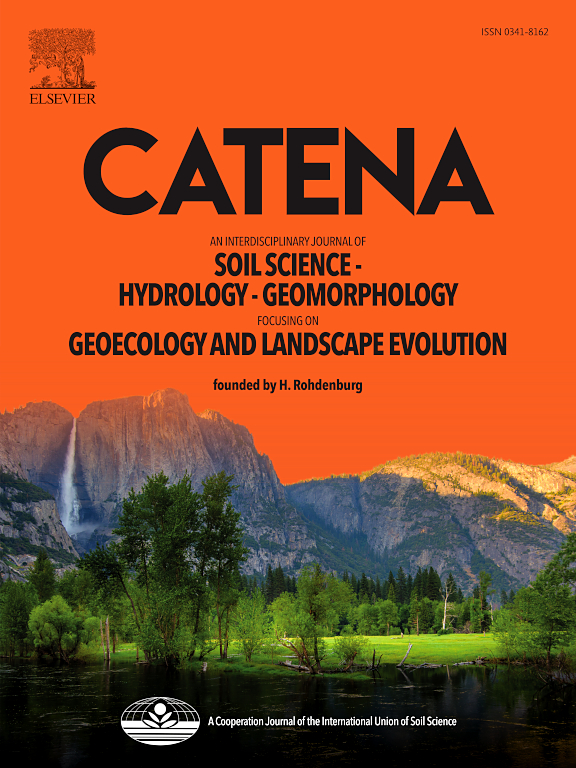A review of the science and logic associated with replacing RUSLE2 by WEPP as an aid to making land management decisions to conserve soil in the USA
IF 5.7
1区 农林科学
Q1 GEOSCIENCES, MULTIDISCIPLINARY
引用次数: 0
Abstract
The Universal Soil Loss Equation (USLE) was developed in the 1960s to predict soil losses by sheet and rill erosion as an aid to making land management decisions in the USA. A subsequent revision, the Revised Universal Loss Equation version 2 (RUSLE2), is now used. The USLE and revised versions of it do not deal directly with the separate effects of raindrops and flow in causing sheet, rill and interrill erosion. Consequently, the Water Erosion Prediction Project model (WEPP) was developed as a process-based model to replace USLE-based technology in the prediction of rainfall erosion in making land management decisions in the USA. Recent comparisons between WEPP and RUSLE2 have identified discrepancies between the two models and these discrepancies can affect the land management options available to farmers if WEPP were to replace RUSLE2 as the primary erosion prediction model in the USA. Some of those discrepancies can be attributed to data input issues, but others result from systemic differences between the two models. WEPP is an event-based model. However, USLE-based technology has been shown predict event soil loss better than WEPP. Logically, RUSLE2 should remain as the primary model for aiding the making land management decisions in the USA until a model that is capable of predicting better event soil loss than USLE-based technology is developed. Also, USLE-based technology can be used to deliver information on sediment delivery, annual variability, probability of occurrence, and risk analysis. The potential to do that in the USA has not been fully investigated.
回顾了与WEPP取代RUSLE2作为美国土地管理决策以保护土壤的辅助手段相关的科学和逻辑
通用土壤流失方程(USLE)是在20世纪60年代发展起来的,用于预测由片状和细沟侵蚀引起的土壤流失,作为美国土地管理决策的辅助工具。随后的修订,修订通用损失方程版本2 (RUSLE2),现在使用。USLE及其修订版本并没有直接处理雨滴和水流在引起片层、细沟和细沟间侵蚀方面的单独影响。因此,在美国制定土地管理决策时,开发了基于过程的水侵蚀预测项目模型(WEPP),以取代基于usle的降雨侵蚀预测技术。最近WEPP和RUSLE2之间的比较发现了两个模型之间的差异,如果WEPP要取代RUSLE2作为美国主要的侵蚀预测模型,这些差异可能会影响农民可用的土地管理选择。其中一些差异可归因于数据输入问题,但其他差异则源于两种模型之间的系统差异。WEPP是一个基于事件的模型。然而,基于usle的技术已被证明比WEPP更能预测事件土壤流失。从逻辑上讲,RUSLE2应该继续作为帮助美国土地管理决策的主要模型,直到能够比基于usle的技术更好地预测事件土壤流失的模型被开发出来。此外,基于usle的技术可用于提供沉积物输送、年变异性、发生概率和风险分析等信息。在美国这样做的可能性还没有得到充分的调查。
本文章由计算机程序翻译,如有差异,请以英文原文为准。
求助全文
约1分钟内获得全文
求助全文
来源期刊

Catena
环境科学-地球科学综合
CiteScore
10.50
自引率
9.70%
发文量
816
审稿时长
54 days
期刊介绍:
Catena publishes papers describing original field and laboratory investigations and reviews on geoecology and landscape evolution with emphasis on interdisciplinary aspects of soil science, hydrology and geomorphology. It aims to disseminate new knowledge and foster better understanding of the physical environment, of evolutionary sequences that have resulted in past and current landscapes, and of the natural processes that are likely to determine the fate of our terrestrial environment.
Papers within any one of the above topics are welcome provided they are of sufficiently wide interest and relevance.
 求助内容:
求助内容: 应助结果提醒方式:
应助结果提醒方式:


